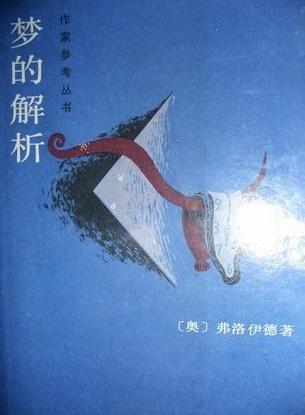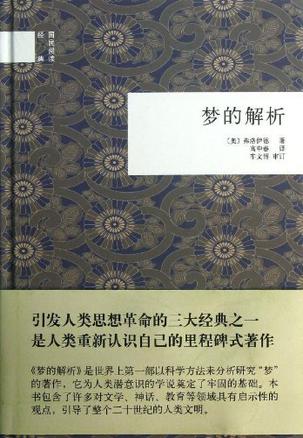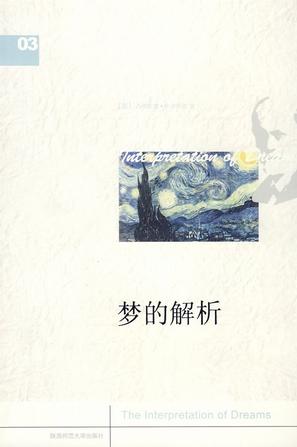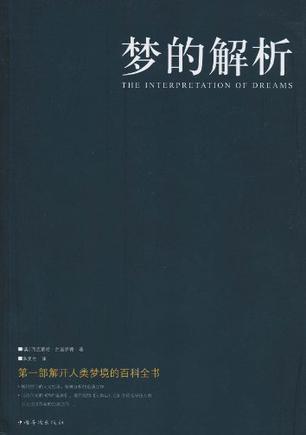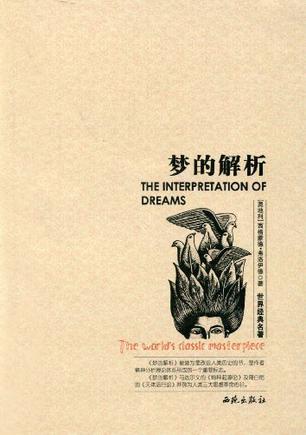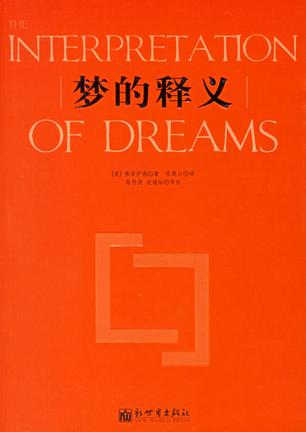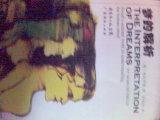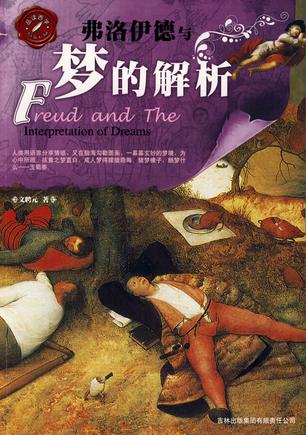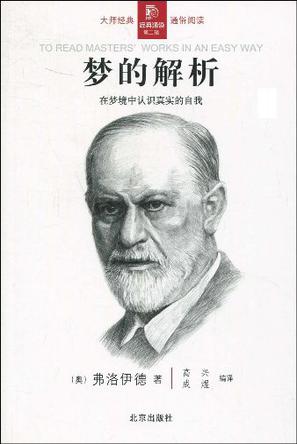欢迎来到相识电子书!
标签:梦的解析
-
梦的解析
序言 1 弗氏原序 1 译序 3 第一章 一九00年以前有关梦的科学研究 3 编者小语 5 第二章 梦的解析方法 11 一个梦的分析 11 前言 19 一八九五年七月二十三日— 二十四日之梦 19 分析 21 第三章 梦的愿望的达成 37 第四章 梦的改装 48 前言 50 分析 58 第五章 梦的材料与来源 75 甲 梦中的最近印象以及无甚关系的印象 76 关于植物学专论的梦 78 分析 79 乙 孩提时期经验形成梦的来源 98 第一个梦 114 第二个梦 118 丙 梦的肉体方面的来源 127 丁 典型的梦 146 一 尴尬——赤身裸体的梦 147 二 亲友之死的梦 153 第一个梦 172 第二个梦 173 第三个梦 173 第四个梦 174 三 考试的梦 177 第六章 梦的运作 189 甲 凝缩作用 190 一个美丽的梦 196 乙 转移作用 211 丙 梦的表现方法 215 丁 梦材料的表现力 240 1 起始的梦 248 2 主要的梦 248 戊 梦的象征——更多的典型的梦例 250 1 帽子,男性的象征(或者男性性器) 258 2 象征着性器官的“小东西”,而以“被车辗过”来象征性交 259 3 象征着性器官的建筑物、阶梯和柱子 261 4 以人象征男性性器官,以风景来象征女性性器官 263 5 孩童阉割的梦 263 6 小便的象征 264 7 楼梯的梦 264 8 一个变异的楼梯的梦 269 9 真实的感觉以及对重复的表现 269 10 正常人梦中的象征问题 271 11 俾斯麦的梦(录自沙克斯的一篇论文) 275 12 一个化学家的梦 279 己 一些例子——算术以及演说的梦 298 庚 荒谬的梦——梦中的理智活动 315 辛 梦中的感情 347 壬 再度校正 373 第七章 梦程序的心理 407 甲 梦的遗忘 410 乙 退化(后退)现象 425 丙 愿望达成 440 丁 由梦中惊醒——梦的功能——焦虑的梦 460 戊 原本的与续发的步骤——潜抑 473 己 潜意识和意识——现实 491 -
梦的解析
《国民阅读经典:梦的解析》的出版,像火炬一样照亮了人类深层的心理活动,揭示了许多隐藏于心理深层的奥秘。《国民阅读经典:梦的解析》不但为人类潜意识的学说奠定了牢固的基础,而且也建立了人类认识自己的新里程碑。《国民阅读经典:梦的解析》包含了许多对文学、神话、教育等领域具有启示性的观点,引导了整个二十世纪的人类文明。 -
梦的解析
弗洛德认为,梦中所见的人物和情景是梦的显象内容,暗藏其中的意义就是梦的隐义。梦的显象只是一些伪装,唯有通过精神分析才能揭示其真情,展露其隐义。弗洛伊德理论的核心是把个体意识分为“本我”、“自我” 、“超我”三个领域。本我以“快乐原则”追求直接性欲的满足;自我以“ 现实原则”为指导,但它受制于本我的意志;超我即“道德化的自我”,它以“至善原则”指导自我,限制本我,以达到自我理想的实现。人的行为的根本动力是无意识的性欲,即“里比多”,人的一切行为都带有性的色彩。人的根本欲望受到自我、超我层面上的道德、社会以及其它各种各样的限制、压抑深藏于潜意识之中。这也是精神疾病的根源。人在睡眠时由于超我监督的松弛,被压抑的冲动和愿望乘机混进意识就成为梦。成年人的梦经过各种伪装,变得神奇不测,因此,梦的出现总是歪曲的,很少与现实相同,虽然如此,但它是欲望的满足。梦是人的意识深层活动的最关键环节,梦的释义是了解人的潜意识的重要途径。这是弗洛伊德对梦进行研究的最重要、最有意义的发现。 《梦的解析》出版于弗洛伊德提出精神分析学说之前,但是它对这种学说有重要的意义。精神分析有三个支柱,即潜意识的心理机制、抗拒和压抑的作用以及性的重要性。这三个支柱的雏形都出现于这本著作之中。不仅如此,而且弗洛伊德后来发展起来的许多重要思想也都是建立在这部著作基础之上的。 -
梦的解析
《梦的解析》出版于1900年,作者是奥地利著名心理学家西克蒙特·弗洛伊德,这是他对心理学最重要的贡献之一,被誉为改变人类历史的书,是精神分析理论体系形成的一个重要标志。该书在作者生前就再版了8次,先后被翻译成多种文字。一直经久不衰。与达尔文的《物种起源》、哥白尼的《天体运行论》并称为导致人类三大思想革命的经典之作。 弗洛伊德在写此书以前,不仅有了充分的思想准备,而且已搜集了大量资料。189'6年和1897年,他已经在维也纳犹太学术厅做了有关梦的演讲。1896年10月,其父亲去世,促使他在先前的理论研究和医疗实践的基础上,开始进行自我分析。可以这样说,他父亲的去世是促使他进行自我分析的主要原因。《梦的解析》第一次告诉曾经无知和充满疑惑的人们:梦是一个人与自己内心的真实对话,是自己向自己学习的过程,是另外一次与自己息息相关的人生。在隐秘的梦境所看见、所感觉到的一切,呼吸、眼泪、痛苦以及欢乐,都并不是没有意义的。弗洛伊德在《梦的解析》中还认为人在清醒的意识下面,还有一个潜在的心理活动在进行着,这种观点就是著名的潜意识理论。《梦的解析》的出版,像一把火炬照亮了人类心理生活的深穴,揭示了许多埋藏于人类心理深层的奥秘。该书不但为人类潜意识的学说奠定了稳固的基础,而且也建立了人类认识自己的新的里程碑。书中还包含了许多对文学、教育等领域有启示性的观点,引导了整个二十世纪的人类文明。 -
解梦
一部用精神分析法破解梦境的百年传世名著,一位颇有争议的西方人文科学界的思想大师。从精神分析法解梦窥视心灵的隐秘,用科学法则把握你的人生命运。 弗洛伊德这个名字,对许多中国人来说并不陌生,他是一个犹太人,出生于奥地利,毕业于维也纳大学医学院。他是本世纪世界名人中最有争议的人物之一。他所创立的精神分析学,在世界上产生了影响。他的学说接触了传统心理学较为忽视的潜意识,扩大了心理学研究领域,使心理学研究的层次加深了,他的学说在文学、医学、哲学等方面都引起了反应。 弗洛伊德以其对人类精神和行为所作出的惊世骇俗的发现,不仅对心理学、哲学、历史学、人类学、社会学、伦理学、政治学、美学等几乎所有的人文学科和精神领域都有研究,他的各种著作便成为了20世纪世界上经久不衰的畅销书。 热心的读者现在手中拿到的这本书,就是根据他的传世之作《释梦》精心翻译出来的。因为本书是他用精神分析法对梦进行研究的心得体会及思想观点和解梦法则,原作没有加特别醒目的小标题,许多章节前后也有重复内容的梦例,而且阅读起来也因过于专业化的词语及冗长的西文名字出现,造成了中国读者对文本本意的理解困难,鉴于这些原因,在本书的翻译过程,译者就从中国人的阅读习惯和兴趣出发,对本书按原意加上了小标题,并对部分较精深难懂的内容进行了删节,使本书尽量地符合现代人的阅读习惯,突出思想性、权威性的同时,体现出了趣味性和可读性。 -
梦的解析
《梦的解析》被誉为是改变人类历史的书,是作者精神分析理论体系形成的一个蘑要标志。《梦的解析》与达尔文的《物种起源论》及哥白尼的《天体运行论》并列为人类三大思想革命的书。 -
梦的解析
《梦的解析》是弗洛伊德的代表作,也是精神分析学的奠基作,同时也可以被看成20世纪人文社会科学最重要的经典之一。《梦的解析》是弗洛伊德用了两年多时间完成的,初版于1900年,差不多10年以后才为人们所重视,在弗洛伊德有生之年就再版了8次并有了近10种文字的译本。 -
第一本心理学漫画书
《第一本心理学漫画书:梦的解析》内容简介:这本漫画是根据弗洛伊德最主要的三部著作《梦的解析》、《精神分析引论》和《精神分析导论讲演新篇》编绘而成,以一个个漫画故事来反应弗洛伊德的整个精神分析的理论体系。创作思路就是希望用漫画这种通俗易懂的形式来表现西方哲学心理学思想,将西方思想名著通俗化、快餐化。 -
梦的释义
《梦的释义》不仅是弗洛伊德思想的奠基石,而且也是人类文化发展史上的一座丰碑。在书中,弗洛伊德以数百个有趣的梦为实例,以流畅的笔触一一分析其中所蕴含的深沉含义,对诸如“梦是什么?”人为什么会做梦?“梦中的情形为什么通常稀奇古怪?”“梦的意义何在?”“梦的原动力何在?”等一系列困扰人类数千年的疑问提出了合理的解释。 -
梦的解析
《梦的解析(英汉对照)》内容简介:在《梦的解析》不多的几个中文译本中,由著名的神经精神科医师赖其万(现居台湾)、符传孝(现居美国)两位先生翻译的这个版本堪称独树一帜,无可替代。两位译者具有精良的专业素养和英文素养,在理解《梦的解析》的理论时,能够更精确地把握弗洛伊德思想的精髓。经过认真比较,我们决定引进这个版本,并且首次以英汉对照的形式出版。 -
梦的解析
《梦的解析》是弗洛伊德毕生最卓越的一部著作,也是弗洛伊德建立精神分析理论体系的一个重要标志。他大量总结前人的研究成果,结合自己对病人的梦的临床研究和对自己的梦的分析,深入地探讨了有关梦的实质、梦的解析方法、梦的伪装、梦的材料和来源、梦的工作以及梦的过程的心理等理论问题。他把象征论作为理论基础,认为梦是对愿望的满足,这不仅提供了开启神经症患者心灵的一把钥匙,而且还成了认知正常人潜意识活动的一条最重要的途径。虽然这部书刚出版时曾受到很大的冷落和责难,第一版共印了六百册,头六周只卖了一百二十三本,历时八年才全部卖完。但《梦的解析》作为弗洛伊德的主要代表著作,其重要性最终被人们认可,在弗洛伊德生前,一共出了八版。《梦的解析》已被视为精神分析学说的重要组成部分和三大理论支柱之一。现在,一些西方学者把《梦的解析》称为“揭示人类心灵的奥秘”之作。美国前全国图书馆协会主席唐斯博士将这《梦的解析》列入“改变世界历史面貌”的十六部巨著之一。 -
THE INTERPRETATION OF DREAMS
Book Description The World Literature series reproduces the greatest books the world over with only the highest production standards. History, philosophy, psychology, political theory, fiction, and ancient texts are now accessible to everyone at an extremely affordable price. This text presents Freud's theory that man is unable to tolerate too much reality, and that dreams are the contraband representations of the beast within man which are smuggled into awareness during sleep. The analysis of dreams is the key to unlocking the vital secrets of the unconscious mind. Synopsis: This groundbreaking new translation of The Interpretation of Dreams is the first to be based on the original text published in November 1899. It restores Freud's original argument, unmodified by revisions he made following the book's critical reception. Reading the first edition reveals Freud's original emphasis on the use of words in dreams and on the difficulty of deciphering them and Joyce Crick captures with far greater immediacy and accuracy than previous translations by Strachey's Freud's emphasis and terminology. An accessible introduction by Ritchie Robertson summarizes and comments on Freud's argument and relates it to his early work. Close annotation explains Freud's many autobiographical, literary and historical allusions and makes this the first edition to present Freud's early work in its full intellectual and cultural context. Amazon.com Whether we love or hate Sigmund Freud, we all have to admit that he revolutionized the way we think about ourselves. Much of this revolution can be traced to The Interpretation of Dreams, the turn-of-the-century tour de force that outlined his theory of unconscious forces in the context of dream analysis. Introducing the id, the superego, and their problem child, the ego, Freud advanced scientific understanding of the mind immeasurably by exposing motivations normally invisible to our consciousness. While there's no question that his own biases and neuroses influenced his observations, the details are less important than the paradigm shift as a whole. After Freud, our interior lives became richer and vastly more mysterious. These mysteries clearly bothered him--he went to great (often absurd) lengths to explain dream imagery in terms of childhood sexual trauma, a component of his theory jettisoned mid-century, though now popular among recovered-memory therapists. His dispassionate analyses of his own dreams are excellent studies for cognitive scientists wishing to learn how to sacrifice their vanities for the cause of learning. Freud said of the work contained in The Interpretation of Dreams, "Insight such as this falls to one's lot but once in a lifetime." One would have to feel quite fortunate to shake the world even once. --Rob Lightner From The New England Journal of Medicine (March 23, 2000) The 100th anniversary of Freud's The Interpretation of Dreams saw the publication of a new translation by Joyce Crick and a "neurophilosophical" treatise on the subject by Owen Flanagan, professor of philosophy, experimental psychology, and neurobiology at Duke University. Taken together, they beg to be read in the light of current ideas about dreams. How far Freud has fallen in the past few decades is clearly reflected in the introduction to the new translation, written by Ritchie Robertson. No, Robertson acknowledges, Freud's theory of dreaming is not scientific; it is not falsifiable, it is embarrassingly sexual and sexist, it undervalues imagery and emotions, and it overvalues verbal repartee. Indeed, Robertson admits, "the scientific study of the mind can proceed with little reference to Freud." Still, he insists, Freud has "helped us to understand the psyche as deep, complex, and mysterious." Is his theory only of historical interest? Freud's own review of the scientific literature of the time suggests that he has not contributed as much as we might think. The content of dreams was already seen by pre-Freudians as determined by previous experiences and as arising in what Ludwig Strumpell referred to as "almost memory-less isolation" from those experiences. Dreams were already seen as bizarre and chaotic, driven, as Freud described the theories of Wilhelm Wundt, by "internal... excitations of the sensory organs." The views of this pre-Freudian scientific community were remarkably similar to those held by neurobiologists and cognitive neuroscientists today. What, then, did Freud add to the study of dreams? Beautiful literature, but mostly bad theory and methodology. Dreams serve to discharge pent-up energy associated with unsatisfied infantile wishes. Dream construction follows a tortured path, with the condensation of many ideas into one and the displacement of their "energies" to unrelated images, all to keep the forbidden wishes from reaching consciousness. Freud's interpretations are stunning: a woman's dream about going to Italy (gen Italien -- to Italy) reflects a hidden wish concerning genitals (Genitalien). Why? Because it is obvious. One is reminded of Plato's "proof" in the Republic that the philosopher-king leads a life that is 729 times more pleasant than that of a tyrant. All in all, Freud's theory of dreams can probably best be described as 50 percent right and 100 percent wrong. Many of his observations about dreams (not their interpretation) are insightful. If viewed as a historical work, perhaps metaphorically, The Interpretation of Dreams can be enjoyable and thought-provoking. But those looking for a scientific explanation of dreaming had best look elsewhere. Even those seeking to use dream interpretation as a clinical tool deserve a more useful model, one more consonant with modern scientific theory. A hundred years after Freud, we seem to be back where he started. In Dreaming Souls, Flanagan seeks to answer philosophical questions about dreaming in the light of what we know about neurobiology. Still, when he talks about dreaming, he is referring specifically to the conscious experience of dreaming, with or without subsequent recall on waking, and not to the underlying physiology of the dreaming state. Although this minimal and somewhat naive attention to physiology is disappointing, it does not make his book uninteresting. Consciousness, he proposes, evolved to solve specific problems, such as how to permit the selective allocation of limited brain resources to just one of many competing sensory inputs -- what we call "attention." What, one might ask, does consciousness offer that the underlying neurophysiology could not handle equally well? Perhaps, Flanagan seems to suggest, consciousness just happened to appear before a "mindless" physiologic alternative did, and it worked well enough. Maybe consciousness and emotions represent just one of many solutions that could have evolved to deal with these problems. Perhaps (and it is a terrifying thought) consciousness could just as easily not have evolved. What about dreaming? This, Flanagan argues, is merely an unintended side effect of waking consciousness; evolution forgot to turn the conscious mind off at night, resulting in dreams that "neither help nor hinder fitness." For Flanagan, the neurobiologic processes underlying consciousness in both waking and sleeping states are of only passing interest and may be, in the end, unimportant. He clearly feels that cognitive processing during sleep serves no evolutionary value, a position that flies in the face of most recent research (for example, on sleep and consolidation of memory). What, then, is sleep for? Flanagan seems to fall back on an old suggestion of Allan Hobson's, that sleep merely serves to allow stockpiles of neurotransmitters in the brain to be replenished. Such an explanation woefully underestimates both the cost and the value of sleep. Still, Flanagan provides a fascinating view of dreaming from the perspective of a modern philosopher. He presents an elegant explication of how dreams, constructed through a chaotic process without intent on the part of the dreamer, can not only still have meaning, but also be self-revealing and useful as well. Even if the experience of dreaming (as opposed to its underlying physiology) arose without evolutionary selection, he argues, it does not follow that dreams are meaningless or that dreaming is useless. Much of what we are was never selected for -- the abilities to solve partial differential equations and to write sonnets and soliloquies were not selected by evolutionary pressures. What we are and what we have evolved to be are not the same. Destiny is not biology, and dreams are not just noise produced by the sleeping brain. Flanagan's provocative commentary would make quick and enjoyable reading for anyone interested in the thoughtful study of dreaming and may yet provide the basis for a new framework for understanding what dreams mean and how they can be used: the goal of dream interpretation. But the big scientific questions remain unanswered. What is the role of sleep in cognitive and emotional processing? How do we integrate these physiologic processes with the phenomenology of dreaming? The time is ripe to address these questions. What might answers to these questions look like? Over the past 10 to 15 years, cognitive neuroscience has proved the existence of multiple, physically distinct memory systems, including working-memory, episodic-memory, and semantic-memory systems. As a consequence, the old idea of consolidating short-term memories into long-term memories has expanded to include concepts of transferring memories from one system to another and then integrating them into complex associative networks. New research suggests that these activities may depend on sleep and might even be the main function of sleep. Processes of memory transfer and integration occur both intentionally (through the frontal cortex) and automatically (through "self-organizing" bottom-up processes). These processes are more complex and more time-consuming than simpler forms of memory consolidation, and they appear to use the same brain regions required for sensory processing. Taken together, they beg for a state in which sensory input is blocked and conscious control of cognitive and affective processing is turned off. Although such a state would be optimal for the automatic reactivation and reprocessing of ensembles of preexisting memories, it would leave the organism dissociated from its environment and unable to interact with it safely. By adding immobility to these other conditions, sleep makes this state of "off-line" memory reprocessing both safe and effective; herein lies the evolutionary pressure for sleep. This, perhaps, is the beginning of a theory worth consideration by neurobiologists, cognitive scientists, and philosophers alike, and the questions it raises are both important and exciting. How would the reliable changes in chemical neuromodulation that are dependent on the stage of sleep, sensory-input gating, generation of electroencephalographic waves, and regional brain activation facilitate off-line memory reprocessing? Which component parts of such a memory-reprocessing system would each sleep stage support? For example, during rapid-eye-movement (REM) sleep, distant and unpredictable cortical associations, but not episodic memories, appear to be preferentially activated, leading to the bizarre, symbolic, and hyperemotional narratives found in classic dreams. In contrast, during non-REM sleep, mentation is generally more linear and thoughtlike. How and why would the brain modulate memory-reprocessing systems in these ways? And, finally, what function, if any, might our conscious awareness of this reprocessing -- what we call dreaming -- serve? I hope that the answers to these questions are not too far away. Reviewed by Robert Stickgold, Ph.D. From AudioFile Freud's most famous and polemic book presents a challenge to narrator Robert Whitfield, who interprets the heavy rhetoric with dispatch and precision, while relating the fascinating dreams with expressive interest and skill. The German text is translated into unstilted English, but the remaining French allows Whitfield to exploit his bilingual ability. Modern medicines have made psychoanalysis less popular than in its heyday, but the impact of Freudian theory on our civilization can never be ignored. For the curious and the serious, Whitfield aptly augments the exploration of this classic book just as a guide aids the tour of an old church. J.A.H. From Library Journal This volume of essays (part of a new series) reflects a wide range of disciplines: sociology, history, literature, and philosophy. Several are works of historic importance by major thinkers, including Wittgenstein and Erikson. Others are more recent works informed by modern thinkers, most notably Lacan. Though of limited appeal to the lay reader in its assumption of a working knowledge of Freud's dream work and its failure to link the essays, the book will interest scholars, particularly those in the humanities concerned with psychoanalysis. Several essays, particularly Meredith Skura's concerning the literary use of dream interpretation, are outstanding commentaries on Freud's landmark work. Paul Hymowitz, Psychiatry Dept., Cornell Medical Ctr., New York About Author Sigmund Freud was born in 1856 at Freiburg in Moravia and died in London in 1939. He embarked on medical studies in Vienna, working at the same time at the Institute for Cerebral Anatomy. Financial circumstances compelled him to postpone his prime interest, pure research, and he became a clinical neurologist. In 1884 he was introduced by Dr. Josef Breuer, a Viennese physician, to the "cathartic" method of treatment of hysteria, which was the starting point of what later became psychoanalysis. Studies in Hysteria was the result of Freud's and Breuer's collaboration in this area. Freud then went on alone to work at "psychoanalysis," examining the structure, nature, and diseases of the mind. As a result of his studies in literature, art, mythology, and religion, he found further evidence to support the revolutionary theories he had discovered in therapeutic practice. The Interpretation of Dreams was first published in 1900. Freud wrote of it in 1931: "It contains, even according to my present-day judgment, the most valuable of all the discoveries it has been my good fortune to make. Insight such as this falls to one's lot but once in a lifetime." Book Dimension : length: (cm)19.8 width:(cm)12.6 点击链接进入中文版: 梦的解析 -
弗洛伊德与梦的解析
《弗洛伊德与梦的解析》介绍了:此刻,弗洛伊德的生活画卷、精神分析、《梦的解析》之神髓在您面前一一呈现。梦,是我们每一个人都会做的,是最普通而普遍的人类精神现象之一,然而又是一种极神秘的精神现象,古往今来的人们尝穷己之力释读之。在人类所有解梦的努力中,有一种被公认为具有相当的科学性——弗洛伊德认为,梦最主要的意义在于梦是梦者愿望的表达,这经过或许是曲折的,间或有许多动人的故事,梦中的情景仿佛一幕现代派风格的荒诞剧或者一个最难解的斯芬克斯之谜一样。且听,谜一样的梦就如此解开。 -
梦的解析
《梦的解析》主要内容:作为精神分析理论体系形成标志的《梦的解析》一书,1956年美国唐斯博士把它列为“改变历史的书”、“划时代的不朽巨著”之一,这是一部与达尔文的《物种起源论》及哥白尼的《天体运行论》并列为导致人类三大思想革命的书。弗洛伊德通过对梦的科学探索和解析,发掘了人性的另一面:“潜意识”,揭开了人类心灵的奥秘。 在这部独创性的著作中,弗洛伊德主要分析了梦的凝缩、梦的转移和梦的二重加工;讨论了梦的隐意内容;解析了愿望满足的原理;描述了俄狄浦斯情结;还说明了幼儿生活对成人条件作用的不可避免的影响。 -
梦的解析
《梦的解析》用简明的语言叙述、通俗流畅的文本以及写实的案例、精美彩图和操作性极强的知识点真实而全面地再现了梦的分析及解梦入门的方法。因此,这是一部集知识性、可读性、操作性于一体的现代人必备的心理自我调适和释梦的经典读本。 -
梦的解析
我尝试通过此书来描述“梦的解析”;我相信,我的这种做法,并没有超越神经病理学的范畴。因为通过心理学的探讨,我们可以认识到梦是许多病态心理现象的首要成分;其他如歇斯底里性恐惧强迫性思想、妄想也是属于此种现象,并且因为有很实际的理由,所以被医生们看重。从后遗症来看,梦其实没有实际意义上的重要性;不过由它成为一种范例的理论价值来看,它的重要性却相对地增加了很多。无论是谁,如果他不能解释梦中影像的来源,那么他也就极不可能会了解恐惧症、强迫证或是妄想症,并且无借此给病人进行治疗。 -
梦的解析
《梦的解析》全面地体现了弗洛伊德的精神分析理论,包含许多对文学、神话、教育等领域有启示性的观点,引导了整个20世纪的人类文明。弗洛伊德第一次科学地揭示人们为什么会做梦,为什么会做奇奇怪怪的梦,梦意味着什么,梦传达着什么,梦将我们引向何方。
热门标签
下载排行榜
- 1 梦的解析:最佳译本
- 2 李鸿章全传
- 3 淡定的智慧
- 4 心理操控术
- 5 哈佛口才课
- 6 俗世奇人
- 7 日瓦戈医生
- 8 笑死你的逻辑学
- 9 历史老师没教过的历史
- 10 1分钟和陌生人成为朋友

